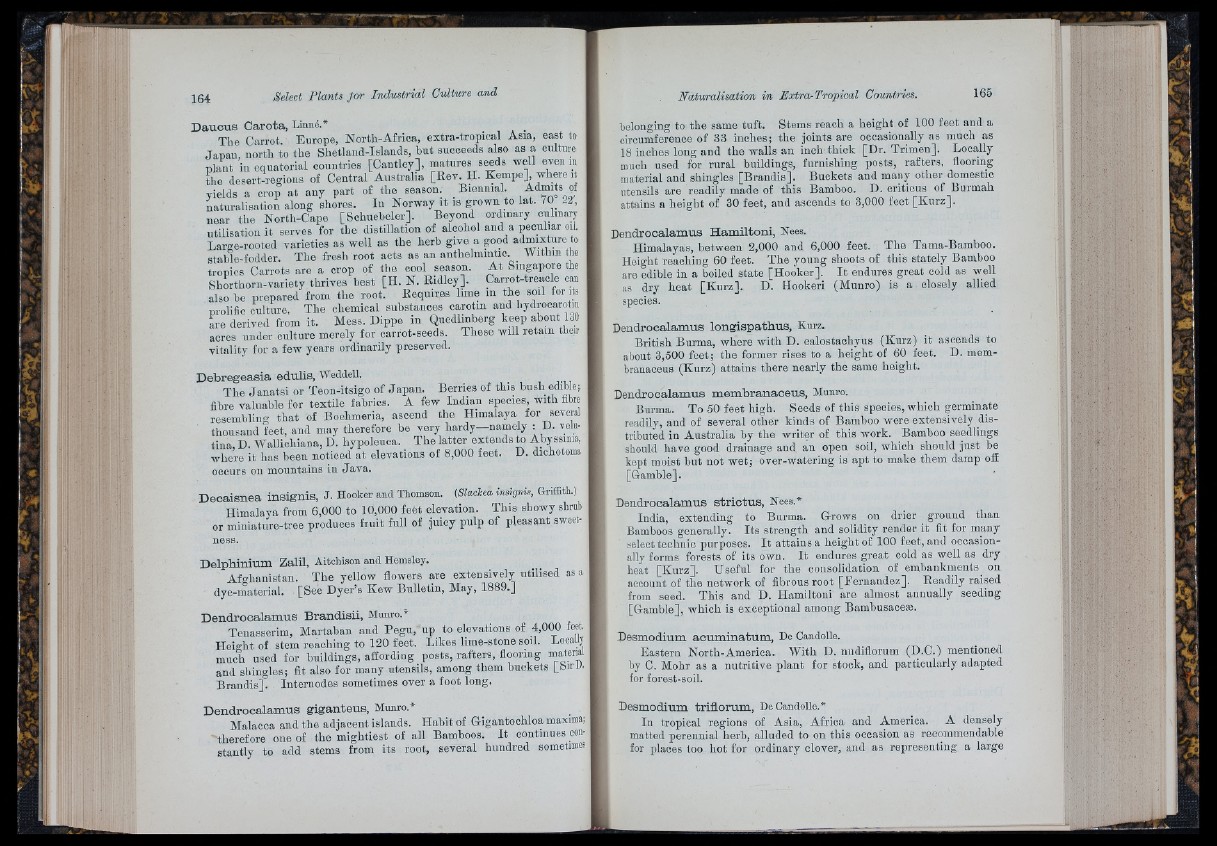
[i ;
D a u c u s C a ro ta . Linné.*
The Carrot. Europe, North-Africa, extra-tropical Asia, east to
Japan north to the Shetland-Islands, but succeeds also as a culture
plant in equatorial countries [Cantley], matures seeds well even in
the desert-regions of Central Australia [Rev. H. Kempe] where it
yields a crop at any part of the season. Biennial. Admits of
Mturalisation along shores. In Norway it is grown to lat. 70 22,
near the North-Cape [Schuebeler]. Beyond ordinary eulmary
utilisation it serves for the distillation of alcohol and a peculiar oil,
Larue-rooted varieties as well as the herb give a good admixture to
stable-fodder. The fresh root acts as an anthelmintic. _ Within the
tropics Carrots are a crop of tlie cool season. A t Singapore the
Shorthorn-variety thrives best [H. N. Ridley]. Carrot-treacle can
also be prepared from the root. Requires lime in the soil for its
prolific culture. The chemical substances carotin and l.ydrocarofin
L e derived from it. Mess. Dippe in Quedlinberg keep about 130
acres under culture merely for carrot-seeds. These will retain their
vitality for a few years ordinarily preserved.
D e b re g e a s ia ed u lis, Weddell.
The Jan a tsi or Teon-itsigo of Japan. Berries of this hush edible;
fibre valuable for textile fabrics. A few Indian species, with fibre
resemblinu th a t of Boehmeria, ascend the Himalaya for several
thousand feet, and may therefore be very hardy—namely : D. Tehi-
tina, D. Wallichiana, D. hypoleuoa. The latter extends to Abyssinia,
where it has been noticed at elevations of 8,000 feet. D. dichotoma
occurs on mountains in Java.
D e c a isn e a in s ig n is , J. Hooker and Thomson. (Slachea insignis, Griffith.)
Himalaya from 6,000 to 10,000 feet elevation. This showy shrub
or m iniature-tree produces fru it full of ju icy pulp of pleasant sweetness.
D e lp b in ium Zalil, Aitchison and Hemsley.
Afghanistan. The yellow flowers are extensively utilised as a
dye-material. [See Dyer’s Kew Bulletin, May, 1889.]
D e n d ro o a lam u s B ran d is ii, Munro.*
Tenasserim, Martaban and Pegu, up^ to elevations of 4,000 feet,
Height of stem reaching to 120 feet. Likes lime-stone soil. Locally
much used for buildings, afEording posts, rafters, flooring materMl
and shingles; fit also for many utensils, among them buckets [birb.
Brandis]. Internodes sometimes over a foot long.
D e n d ro o a lam u s g ig a n te u s , Munro.*
Malacca and the adjacent islands. Habit of Gigantoohloa maxima;
therefore one of the mightiest of all Bamboos. I t continues eon-
stantly to add stems from its root, several hundred sometimes
belonging to the same tuft. Stems reach a height of 100 feet and a
ciroumfereuce of 33 inches; the joints are occasionally as much as
18 inches long and the walls an inch thick [Dr. Trimen]. Locally
niiicli used for rural buildings, furnishing posts, rafters, flooring
material and shingles [Brandis]. Buckets and many other domestic
utensils are readily made of this Bamboo. D. critieus of Burmah
attains a height of 30 feet, and ascends to 3,000 feet [Knrz],
D endrooalamus H am ilto n i, Nees.
Himalayas, between 2,000 and 6,000 feet. The Tama-Bamboo.
Height reaching 60 feet. The young shoots of this stately Bamboo
are edible in a boiled state [Hooker], I t endures great cold as well
as dry heat [Kurz]. D. Hookeri (Munro) is a closely allied
species.
Dend ro o a lam u s lo n g isp a tb u s , Kurz.
British Burma, where with D. calostachyus (Kurz) it ascends to
about 3,500 feet; the former rises to a height of 60 feet. D. mem-
branaceus (Kurz) attains there nearly the same height.
D en d ro o alam u s m em b ra n a o e u s , Munro.
Burma. To 50 feet high. Seeds of this species, which germinate
readily, and of several other kinds of Bamboo were extensively distributed
in Australia by the writer of this work. Bamboo seedlings
should have good drainage and an open soil, which should just be
kept moist but not wet; over-watering is apt to make them damp o3
[Gamble].
D en d ro o alam u s s t r ic tu s , Nees.*
India, extending to Burma. Grows on drier ground than
Bamboos generally. Its strength and solidity render it fit for many
select technic purposes. I t attains a height of 100 feet, and occasionally
forms forests of its own. I t endures great cold as well as dry
heat [Kurz]. Useful for the consolidation of embankments^ on
account of the network of fibrous root [Fernandez]. Readily raised
from seed. This and D. Hamiltoni are almost annually seeding
[Gamble], which is exceptional among Bambusace®.
Desmodium a c um in a tum , He Candolle.
Eastern North-America. With D. nudiflorum (D.C.) mentioned
by C. Mohr as a nutritive plant for stock, and partioularly adapted
for forest-soil.
Desmodium tr iflo rum , De Candolle.*
In tropical regions of Asia, Africa and America. A densely
matted perennial herb, alluded to on this occasion as reeommendable
for places too hot for ordinary clover, and as representing a large